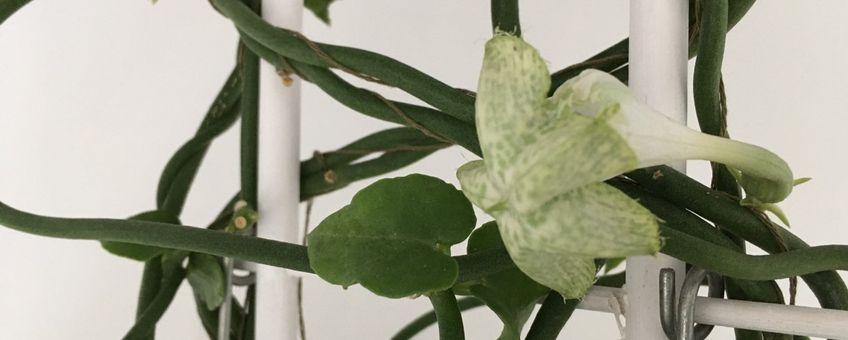
Parachute plant optimizes pollination with modified stamens
Naturalis Biodiversity CenterSpecies in the plant genus Ceropegia (Milkweed family) are famous for their outstanding flowers: five petals are fused to form a pitfall, and small flies are temporarily trapped inside the flower. The species Ceropegia sandersonii is known as the parachute plant because its pitfall flowers look a lot like a little parachute.

Thanks to its eye-catching and quite decorative flowers, this succulent climber from South Africa became a popular houseplant on window sills throughout the world. But it also came to scientific fame as a flagship species representing a genus of plants with pretty but unusual flowers and extraordinary pollination strategies. With a combination of an irresistible fragrance, resembling food, and a slippery floral surface, plants in the wild lure tiny flies under their parachute and into their funnel shaped pitfall flower. The inner surface of the funnel is slippery so that falling down is a one-way ticket, at least momentarily.
Temporary prison
 The basal inflation is a temporary prison for flies. This flower part contains the reproductive organs. Once trapped, the flies eagerly try to find an exit; however, they can only escape once the parachute gradually turns upside down and the slippery funnel is no hindrance anymore; this is the case once the flower is withering after pollination. A remarkable and highly specialized novel floral organ plays a key role in forcing the flies to become pollinators in return for their freedom.
The basal inflation is a temporary prison for flies. This flower part contains the reproductive organs. Once trapped, the flies eagerly try to find an exit; however, they can only escape once the parachute gradually turns upside down and the slippery funnel is no hindrance anymore; this is the case once the flower is withering after pollination. A remarkable and highly specialized novel floral organ plays a key role in forcing the flies to become pollinators in return for their freedom.
Positioned between the prison wall, formed by the fused petals, and the reproductive organs, sits a crown-shaped structure: the corona. It is an additional floral organ surrounding the reproductive organs and promoting successful reproduction. The corona forms five tiny cavities. During their desperate search for an exit, trapped flies stick their head into these cavities. While stuck head over heels in such an opening, the flower clips a package full of pollen onto the flies’ proboscis; or, in case a fly with a pollen package entered the flower, the package is removed and the flower is pollinated. In this process, the corona acts as a 'fly filter'. Only flies with the correct body size, that fits into the cavities, can remove or deposit pollen packages. This allows for very specific pollen transfer and reproductive success.



But how?
The evolutionary origin of the corona has been debated for a long time. In some species it is assumed to be derived from petals, in others from stamens, and it can also be a combination. In Ceropegia species and their closest relatives, the corona was suggested to develop from stamens only. To explore the origin of this most astonishing floral organ, its development was investigated from tiny floral buds up to fully developed flowers with different analytical techniques.
Expression of developmental genes typical for stamen development was detected in the corona. Position and timing of corona development clearly indicate that it is stamen derived as well. The corona sprouts from the stamens once they have reached a certain size.
Fly filter
Finally, 3D scans of the corona did not show any signs of vascular tissue. The combination of these findings led to the conclusion that the corona of Ceropegia sandersonii, and likely of all Ceropegia species, evolved from stamens. Millions of years of evolution gradually shaped it into a separate organ with an entirely new role: that of a fly-pollinator filter.
More information
- The full article: Pitfall Flower Development and Organ Identity of Ceropegia sandersonii (Apocynaceae-Asclepiadoideae)
Text: Annemarie Heiduk and Monique Welten, Naturalis Biodiversity Center
Photos: Annemarie Heiduk; Monique Welten
